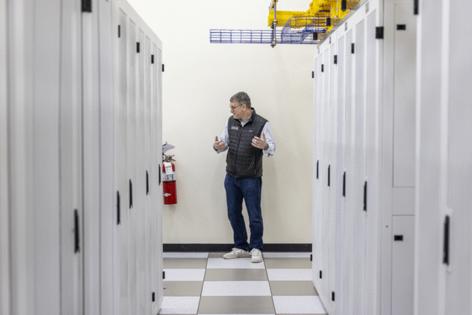How Comcast's fast internet gets from data centers to your home, with the help of new tech and AI
Published in Science & Technology News
How fast is your internet?
For Comcast customers in Philadelphia, the ceiling for speed just got higher.
And it's made possible by what goes on inside a dull-looking Northeast Philadelphia office building where state-of-the-art technology is powering the network 24/7.
In recent months, the majority of Comcast's residential and business customers in the city have gained access to the company's "next generation internet speeds" — 2.1 gigabits-per-second (Gbps) for downloading and 300 megabits-per-second (Mbps) for uploading, company executives said.
The milestone puts Comcast's hometown ahead of the nation. Across the country, about half its more than 30 million internet customers have access to those speeds as of early April. The company said it aims to increase that number to 70% nationwide by the end of the year.
And there's more to come, said Elad Nafshi, Comcast's chief network officer, as he showed The Inquirer around a Philadelphia data center.
"People say, 'How fast do you need the internet to be?'" he said. "How fast do you need your entertainment? How fast do you need your work-from-home to be? How fast do you need all your connected devices to be?"
"In my mind, there's never fast enough."
When Nafshi joined Comcast 20 years ago, the company offered residential download speeds of about 3 megabits per second. Since then, he noted, max internet speeds have increased by a factor of nearly a thousand.
Comcast, which reported record revenue in the fourth quarter of 2025, is pouring money into its network, having already invested $20 billion over the past five years. In the past three years, more than $2 billion was invested in Pennsylvania.
And the company is trying to attract more customers by initiating regular speed upgrades for no extra cost and on Tuesday offering a five-year price guarantee as low as $55 a month for new internet customers (existing customers can also roll into one of the packages).
Comcast data center shows internet's evolution
Inside a nondescript brown building in Northeast Philadelphia, some of the nation's most sophisticated new technology is working 24/7 to get internet, cable, and phone services to thousands of customers.
As a C-suite executive, Nafshi primarily works out of the Comcast Technology Center, which shimmers from its perch atop the Center City skyline. But the technical magic happens miles away, in this unassuming single-story building where five people work full-time.
"What I'm going to show you is the progression: What happened before the internet, how did we start to deliver the internet, and then we're going to go into how we're going to deliver the internet into the future," Nafshi said, his face lighting up with enthusiasm as he walks through a small, white lunchroom and out a back door.
Under a dreary early-April sky, he points to the past, a small stand-alone structure that once facilitated old cable and analog TV service.
"You'd have antennas that pick up the channels, and they would bring it to a site like this. From here, it would get distributed to the general area," Nafshi said. "And then the internet came along and you need all of the devices to be able to serve that cable-modem in your house. That is when this building was built."
He motions to a slightly larger structure next door. Inside, there is just enough room to move around between crammed aisles full of multicolored wires plugged into a hodgepodge of darker-colored cabinets. Fans whir, keeping the technology cool.
"They basically connect up to the cloud," he said. "From here, it fans out everywhere in the Northeast area of Philadelphia and ultimately into our computers at home. Each one of the wires you see over here connects to a point of distribution that sits typically within half a mile away from your home."
There are about 1,200 of these rooms nationally, he said, and dozens across the Philadelphia area, as some customers still get their services distributed from here.
"You get gig [gigabit] services out of these devices. So they're pretty fast," Nafshi said. "This is the infrastructure that delivered the internet during COVID."
But as Comcast looked to the future, he said, the team decided they could do even better.
Comcast looks to the future of internet
A few years ago, the Comcast team got to work creating even faster, more reliable, and more sustainable technology.
The finished products sit in a bright white room, feet from the older data center yet much more spacious. Inside the newer room, there are no multicolored wires. Instead, there are neatly organized fiber-optic cables, powering fiber internet, which uses light to transmit data through glass.
"Think about how fast light is," Nafshi said. "We're able to feed much more reliably, much faster."
Everything in this room is "Comcast innovation," including the software that keeps the network running, Nafshi said. In 2023, it won Comcast an Emmy for Technology and Engineering.
"This runs a tremendous amount of AI that we were able to build and develop at Comcast," Nafshi said. "There's AI that originates from here and goes up and looks at your home every 20 minutes, and basically says, 'Are you getting everything you need out of your service?'"
The AI analyzes 4,000 data points across more than 50 million devices connected to Comcast's networks, optimizing the connection as needed, Nafshi said. More than three-quarters of those network issues are "self-healed" by AI, he said.
And if there are larger issues — such as a car crashing into a utility pole or a squirrel chewing through the fiber cable — AI enables Comcast technicians to pinpoint exactly where the break is, making for "faster repair than any one of our competitors," Nafshi said.
Across the country, there are about 200 of these new data centers, Comcast executives said. In the Philly region, there are only a couple.
"This location is built to continue to grow. This location is built to continue to innovate," Nafshi said. "We're not done."
It's hard to even say what internet speeds might be needed in the future, Nafshi said, given how streaming, gaming, and other technology has evolved just in the last couple decades.
"Think about how seamless the internet is right now ... you don't even think about it," Nafshi said. "It used to be you needed a different wire to connect to this and a different wire to connect to that."
"What really excites me is: What else? What could we be connecting to and how could we be interacting with it five years from now? I don't think we can even dimentionalize it right now," he said. "At Comcast, we're building a network that will enable you to do that seamlessly regardless of what comes next."
©2025 The Philadelphia Inquirer, LLC. Visit at inquirer.com. Distributed by Tribune Content Agency, LLC.












Comments